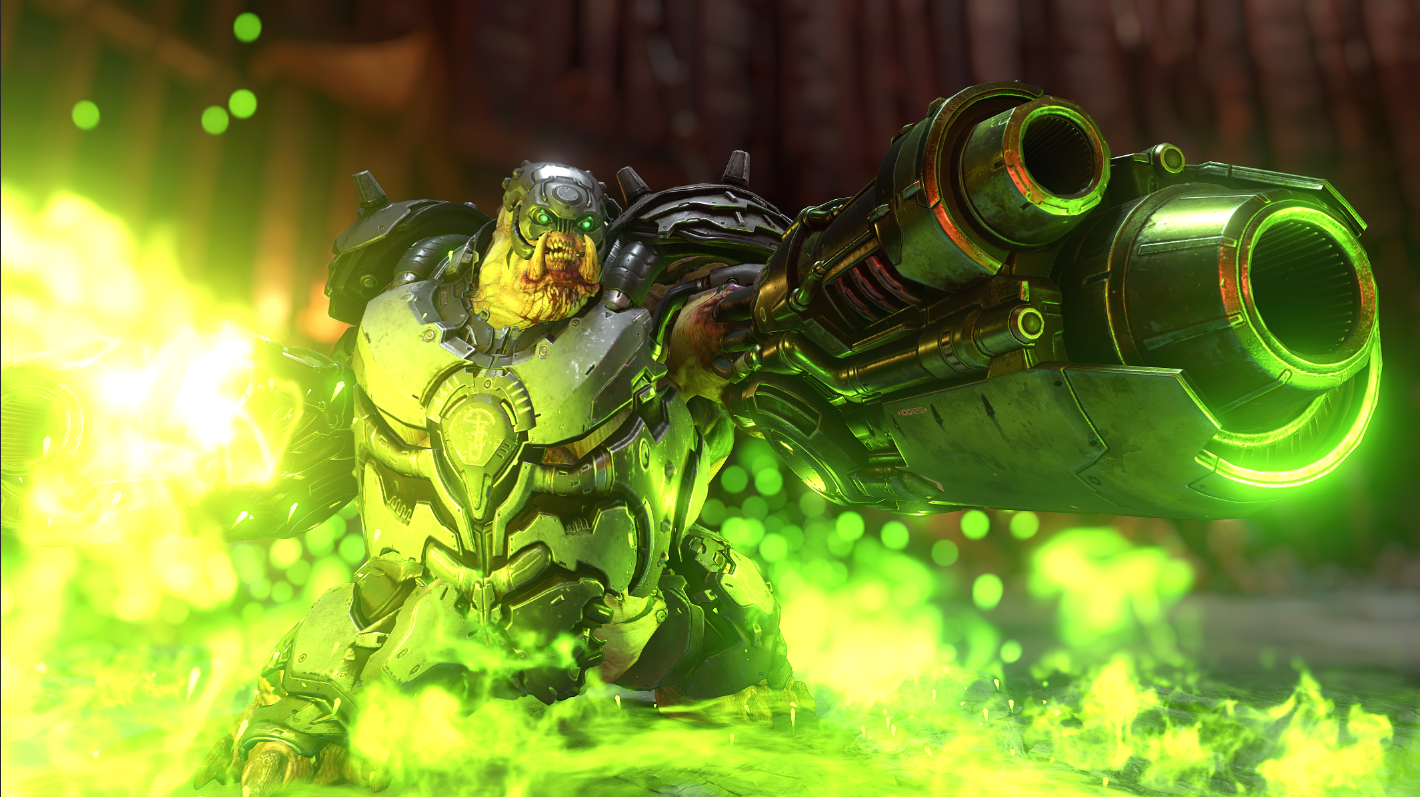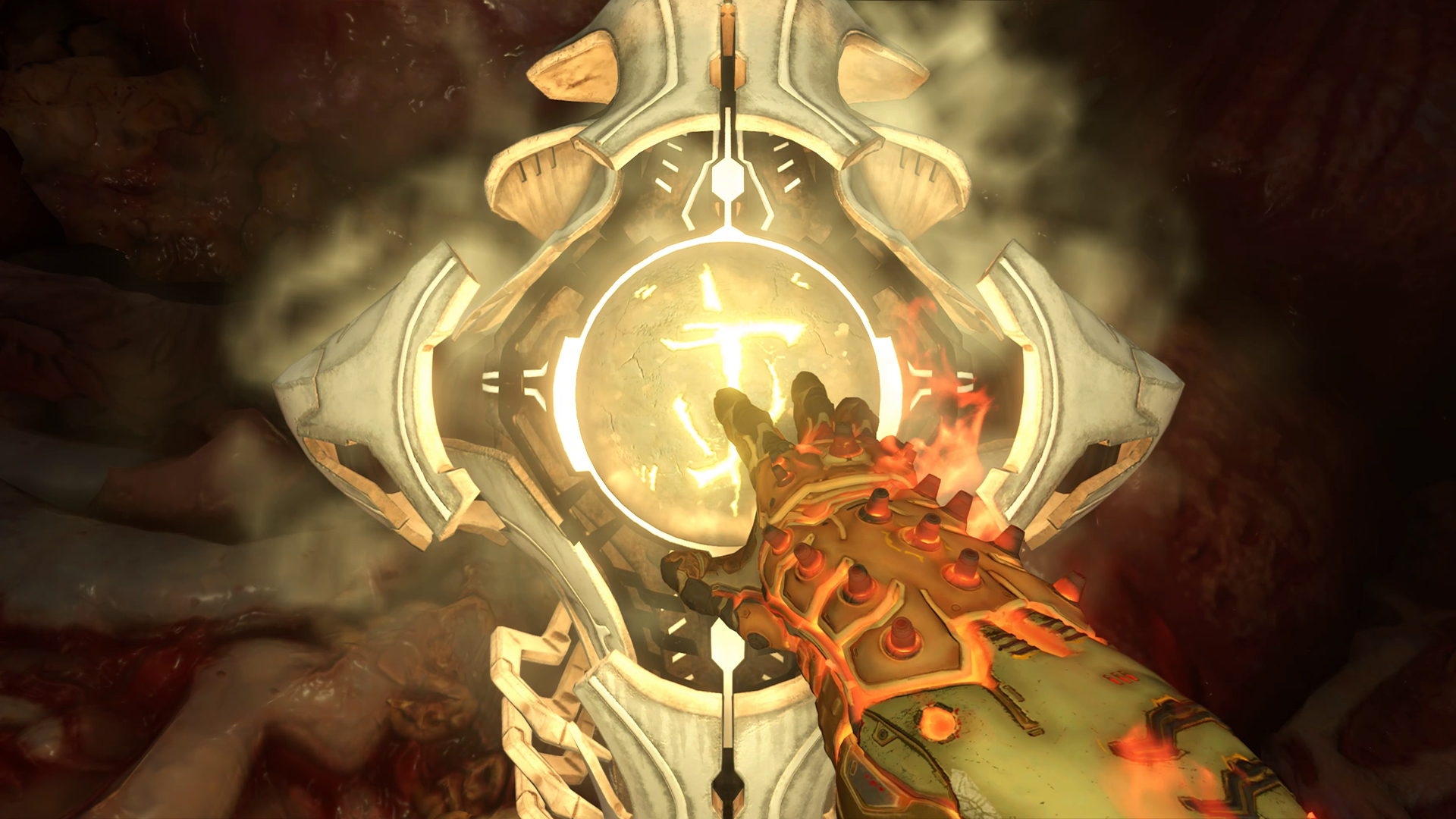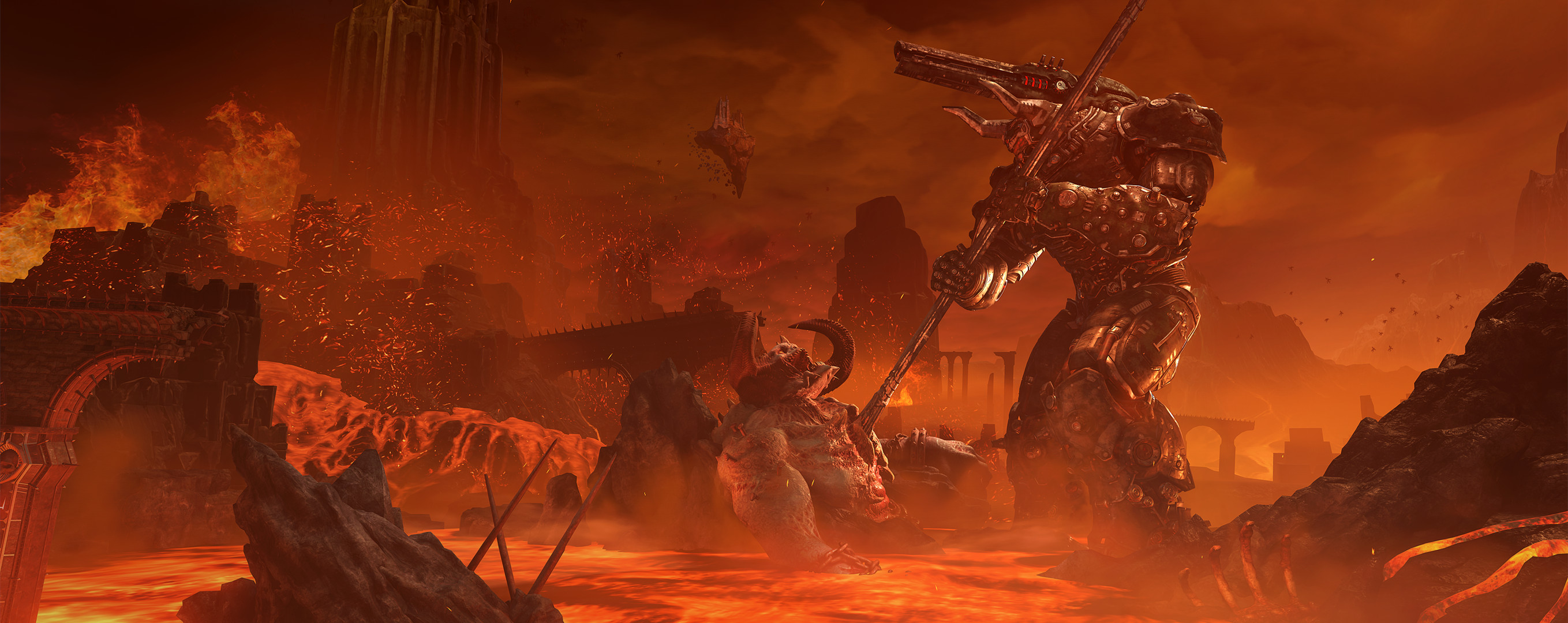Doom Eternal is a relentless assault of ferocious ultraviolence
Fast, brutal, and metal as hell, this is the most gleefully manic FPS since 2011's Bulletstorm.
Doom Eternal is exhausting. After playing it for three hours, I felt like my nervous system needed a vacation. Any good first-person shooter demands something from your reflexes, learning how to land headshots and juggle guns while dodging incoming fire, but that's basically just learning how to breathe in Doom Eternal. Properly operating your entire body—and staying alive—is a whole lot harder.
Eternal's goal is to give you superpowers and then force you to learn how to use them instinctively, or you die
Doom Eternal on Ultraviolence, its 'hard' difficulty, is the most stressed I've been playing a game in a long time, because almost every fight had me feeling like I was on the ragged edge. It's been a couple years since I played any of id Software's 2016 Doom, the surprisingly great reboot that Eternal is following up on, but I don't remember it feeling like this. Doom was fast, rabid, and satisfying in its brutality and the ways it encouraged aggression to stay alive. You had to perform melee 'glory kills' to wrench life-refilling power-ups from enemies, and you'd pull out the chainsaw at key moments to turn an enemy into a geyser of blood and ammo refills. Eternal starts at a level of intensity Doom may have reached towards the end.
The sequel gives you those basic tools in the first five minutes, and then it keeps layering on more for the first three hours (and likely beyond). Honestly, it's overwhelming, but Eternal's goal here is to essentially give you access to superpowers and then force you to learn how to use them instinctively, or you die. It's definitely following the Crank: High Voltage playbook on how to make a sequel.
At least on hard, all the enemies except the shambling fodder move fast, are aggressive, and can tear you to pieces in seconds, which means constantly closing range to get melee glory kills that restore your health becomes second nature. But that's hardly enough to keep you alive for long. The biggest source of tension, for me, was remembering to use each of the new cooldown abilities Eternal introduces while also monitoring my weapons swapping between weapons when needed.
There's now a grenade you can use to soften up a group of enemies, and later you can swap it out for a cryo grenade that freezes them instead. Heavier demons have weak spots that the grenade can help you destroy, robbing them of major damage potential or even opening them up for a glory kill. If you don't remember to use the grenade when it's off cooldown, you're probably dead, because Doom Eternal throws a lot of enemies at you at once.
There's a dash move now that you can use twice in a row. If you don't use it constantly you're probably dead, because Doom Eternal's enemies are aggressive, and they're fast. More than once I embarrassed myself by missing shotgun blasts at imps as they leaped circles around me faster than I could track them.
There's the flame belch, which sets enemies on fire, and while they're on fire, you can shoot them to get armor pickups, in the same way glory kills give you help. If you don't remember to use the flame belch constantly, you're definitely dead. That armor is essential.
Keep up to date with the most important stories and the best deals, as picked by the PC Gamer team.
Then there's your actual weapons, staples like the shotgun and heavy cannon and plasma rifle, which each have mods that can save your ass in the right situation. One time I vented the built-up heat from my plasma rifle to blast out a shockwave that saved me from a Hell Knight who was getting ready to knock my head off. I was constantly switching between guns to use whatever was best in the moment, or because I'd just run out of ammo for one and was scrambling to stay alive.
Within the first three hours I had all of the above, plus the rocket launcher, and I'd been introduced to a handful of other powerup systems. There are relics which give you special abilities, like the 'blood punch,' which you charge up by performing glory kills. It gives your punch an extra area of effect and deals a lot more damage, so you can One Punch Man your way through a crowd. There's an upgrade system for those relics. There are also suit upgrade points, which can be spent on enhancements like vacuuming power-ups in from further away or lowering ability cooldowns. And you can upgrade weapon mods, leading to a fully decked-out gun can then get some kind of final special power boost.
It's a lot.


Doom Eternal release date: Everything we know
Doom Eternal review: Our definitive verdict
Doom Eternal tips: Weather the steep difficulty curve
Doom Eternal Slayer Keys: Unlock the optional encounters
Doom Eternal Runes: Give Doomguy the edge
Doom Eternal settings: Kill in high-res glory
Doom Eternal computer code: Uncover a special treat
Doom Eternal cheat codes: Escalate the action
Doom Eternal Battlemode: Tips for victory
Eternal doesn't hesitate to throw all these systems at you in the first three hours, like a sadistic juggling instructor lobbing live chainsaws at you. It's bold, not the way most triple-A videogames would do it, and I admire the chutzpah even if a smoother ramp up would've been more pleasant. You can feel how eager id's designers were to give you everything, rather than slowly re-tell the origin story of becoming Doom Guy.
In some games, obtaining all those guns and upgrades is the fun; the reward loop is what the game is about. Doom Eternal hands over its treasures casually, because its reward is walking straight into Hell to rip and tear.
The few times I came out of fights in Doom Eternal without coming close to dying, I felt really smart. It meant I'd done a good job of dodging and aiming, landing headshots and aggressively using glory kills to keep my health up, but more importantly it meant I'd actually managed to execute on something approximating a plan. Like, okay, I'm going to shoot a grenade into the cacodemon's mouth first, which will let me kill him with a melee finisher, then I'll flamebelch a crowd and pick up as much armor as I can, then switch to the shotgun and keep running forward without stopping to put some distance between me and the mob. There's a Revenant, too—better shoot off his missile launchers so he's less of a threat and easy to glory kill.
This all happens super fast. It's a mix of instincts and in-the-moment planning, which is what makes Doom Eternal so exhausting—your situational awareness has to be running in overdrive at all times. It's really fun, but absolutely not relaxing.
I'm sure on lower difficulty settings Doom Eternal feels a little bit less frantic, but creative director Hugo Martin told me they want people to have the same experience no matter the difficulty setting. Doom Eternal is designed to make you constantly switch weapons and use everything in your arsenal to make it through. The more aggressive enemies push you to use the flame belch to build armor; the weak points on heavy-hitters like the Mancubus and Revenant force you to use grenades or specific weapon mods to cripple them. Sticking to the Super Shotgun isn't going to cut it this time.
Doom's legacy has been distilled down into speed, violence, demons, and shooting, but so much of classic Doom was actually moody exploration of intricate levels
Purely for its combat, Doom feels like it already has a good shot at being the best shooter of 2020. I also saw some really, really cool art design in the first couple hours, with enormous demonic doors and the giant bodies of preserved ancient warriors. This is a Doom game with lore, and it's cool, in a cheesy Dragonforce lyrics kinda way. In a couple hours I met a ghost king, a brooding guy named The Betrayer whose face had definitely seen better days, and used some kind of talisman to unshield the soul of a Hell wizard before pulling his head off with my bare hands. Eternal is definitely going bigger with the Doom universe, but still keeps it out of the way of the action.
There is downtime between the insanity, too, with some platforming segments and some short quiet moments to soak in the luxurious art, but at least in these opening hours, Doom Eternal seems determined to make its combat so complex, it can sustain your interest and stay engaging for an entire campaign.
I was so focused on living through every fight and trying to remember every weapon at my disposal that I didn't even realize, until later, that the essence of '90s Doom was largely absent. Over time Doom's legacy has been distilled down into speed, violence, demons, and shooting. But so much of classic Doom was actually moody exploration of intricate levels; the spaces you explored made Doom Doom as much as the guns did.

That level design isn't really on display in the opening hours of Doom Eternal. There are absolutely secrets to be found and side paths to go down, but Eternal is more focused on funneling you from one intense fight to the next than to more intricate exploration. Towards the end of levels it does give you the ability to fast travel back to earlier rooms, and there are side challenges you'll want to revisit to earn more upgrade points and so on. Hopefully the game settles into a less manic pace as it goes, and makes the act of progressing through complex spaces as integral and rewarding as the combat.
Doom 2016 pulled off that balance beautifully, and Eternal is such a more is more sequel it may end up being lopsided in its focus on the shooting. But if the whole game keeps me on my toes as much as the first three hours, I don't know if I'll mind. As long as my heart can take the sustained stress, anyway.
We won't have to wait long to see how the whole game plays out, because Doom Eternal hits PC on March 20th.

Wes has been covering games and hardware for more than 10 years, first at tech sites like The Wirecutter and Tested before joining the PC Gamer team in 2014. Wes plays a little bit of everything, but he'll always jump at the chance to cover emulation and Japanese games.
When he's not obsessively optimizing and re-optimizing a tangle of conveyor belts in Satisfactory (it's really becoming a problem), he's probably playing a 20-year-old Final Fantasy or some opaque ASCII roguelike. With a focus on writing and editing features, he seeks out personal stories and in-depth histories from the corners of PC gaming and its niche communities. 50% pizza by volume (deep dish, to be specific).

